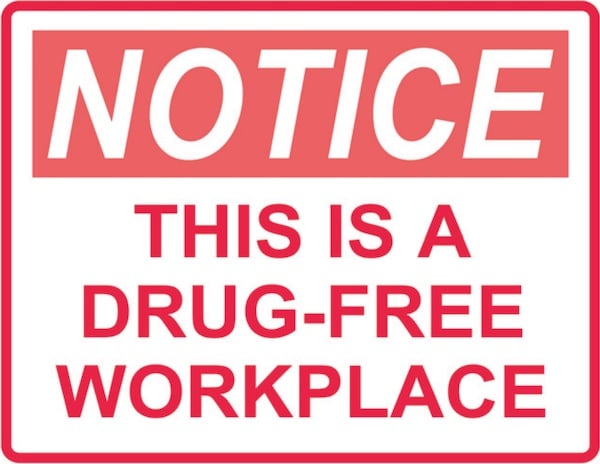Introduction & Overview
The cornerstone of a Drug-Free Workplace is having a well-thought-out and comprehensive Drug and Alcohol Screening Policy that meets legal requirements, supports your organization hiring policies and needs, and fits with your organization’s culture.
Legal Requirements
- Federal Laws and Regulations
- Federal Contractors, Grantees, and Federally Regulated Industries
- Considerations for Safety and Security Sensitive Industries
- State and Local Laws and Regulations
For an overview of best practices for complying with legal requirements, review 10 Steps for Avoiding Legal Problems.

Marijuana
At the Federal level, marijuana is classified as a schedule 1 drug which means it is illegal to possess.
Legal Marijuana - Medical or Recreational
As of September, 2023, thirty eight states, the District of Columbia, Guam, and the US Virgin Islands have approved comprehensive, publicly available medical marijuana and cannabis programs. Twenty three states and Washington, DC, have legalized adult recreational use, and changes occur regularly regarding medical and recreational marijuana. Critically important in the development of any drug and alcohol screening policy are considerations regarding marijuana—medical or recreational.

State marijuana laws must be considered for non-DOT policies. Depending on various state laws, companies must decide to test for marijuana or not. Companies must also consider whether they are going to make any accommodations for authorized medical marijuana cardholders.
Employers in marijuana-friendly states are advised to practice caution when facing a positive marijuana test and potential action against an employee. It is recommended that an employer seek counsel from an informed state-specific attorney to learn how to respond to a positive test for marijuana that could have resulted from off-duty use.
Learn more about marijuana in the workplace and State laws regarding workplace testing for marijuana.
Supports Your Organization Hiring Policies
It is very important to remember that your Drug Screening & Alcohol Testing program is part of your organization’s overall hiring process and must be written so that it aligns with your hiring strategies, practices, and desired outcomes. As your hiring strategies evolve or change it is important to make sure that your Drug Screening & Alcohol Testing program is in lock-step with the evolution of your hiring.
For example, it is not at all uncommon for organizations to loosen their DSAT standards when the job market is very tight and it is a difficult to hire sufficient personnel.
Fits With Your Organization’s Culture
It is important for your employees to feel safe at work, but drug use poses the potential for accidents or injuries that could impact their safety. If employees are confident in your company’s policy toward illegal drugs, they are more likely to stay motivated through hard times.
Your employees deserve a safe workplace—and that starts with clear policies. Is it time you implemented a comprehensive, drug-free workplace policy? If so, do you now know where to start?
In this white paper, we will discuss how you can create such a policy for your company. And we will examine a drug and alcohol screening policy as one component of a drug-free workplace.
A Drug-Free Workplace
The Substance Abuse and Mental Health Services Administration (SAMHSA), a division of the US Department of Health and Human Services (DHHS), defines the drug-free workplace as one that includes the following five key components:
- A written policy
- Employee education
- Supervisor training
- An employee assistance program (EAP)
- Drug and Alcohol testing
The United States Department of Transportation (DOT), and many state programs, follow this same model.
Are you ready to discuss a custom policy or policy update for your company? Call 866-843-4545 for expert assistance.
Reasons to Implement a Drug and Alcohol Screening Policy
Drug-free workplace policies are a must for most companies. Such policies are often implemented for the following reasons:
- Required by federal law and the United States Department of Transportation (DOT)
- Required because your organization receives federal funding for a contract or grant
- Required by state or local contracts
- Required by your insurance company
- Required by your customer, the organization you are working for
- Because you want a safe and healthy workplace for your employees
- Because you want to limit exposure to liability in your drug and alcohol testing program
- Because you want more productive employees with less turnover, less absenteeism, less tardiness, as well as reduced workers compensation cases and cost
- Required by a State program granting you a discount on workers compensation insurance
- Required by your workers compensation insurance company
Basic Steps to Develop Your Policy
Your drug-free workplace initiative can be an invaluable tool to strengthen your business and protect your employees from the hazards of alcohol and other drug misuse.
These six steps will help you build a customized program:
- 1. Perform a needs assessment related to substance abuse.
- 2. Identify the regulations, state laws, and best practices you will need to incorporate into your policy.
- 3. Identify the testing methods (hair, urine, oral fluid, or alcohol testing) and venders for testing (collection sites, labs, and a medical review officer).
- 4. Identify reasons for testing including pre-employment, random, post-accident, reasonable suspicion, return to duty, and follow-up.
- 5. Identify any access for employees to employee assistance programs (EAPs) or resources for counseling, rehabilitation, or treatment.
- 6. Identify plans for distributing the policy and providing employee and supervisor training.

The policy should begin with a statement of purpose—why you are implementing the policy. The statement of purpose should contain the organization’s policy goals, its definition of substance use, and a description of how and why the policy was developed. The goal may be safety, compliance with regulations, or guidelines designed to help prevent accidents at work.
The Key Elements of a Good Drug-Free Workplace Policy include addressing the following items:
- How does the organization define substance abuse?
- Who is responsible for answering any questions about the policy?
- Who is responsible for carrying out and enforcing the policy?
- Who is covered by the policy?
- What employee behaviors are expected?
- What illicit substances are being tested for?
- Are any employees covered by the terms of a collective bargaining agreement, and, if so, how do the terms affect the way the policy will be carried out and enforced for those employees?
- When will the policy apply? (For example, will it apply during work hours only, or also during organization-sponsored events after hours?)
- What types of drug and alcohol testing will be required?
- Who gets tested? (pre-employment and post-hire)
- When are drug tests given?
- Who conducts the drug testing?
- Who pays for drug testing?
- What steps are taken to ensure the accuracy of the drug tests?
- What type of assistance is available to employees needing help?
- What are the consequences for employees violating the policy?
- What are the legal rights of employees who test positive, how is the test results challenged?
- Will the company allow return-to-work agreements, second chance or last chance agreements?
- How is employee confidentiality protected?
- Are employees required to notify supervisors of drug-related convictions?
- Clear communications about the organization’s ‘No Expectancy of Privacy’ policy which pro-vides that the organization has the right to in-spect all devices, equipment, property, facilities, etc. provided to employees without notification.
Ensuring your drug-free policy fully addresses these elements is essential for success. Your policy needs to be detailed and cover each and every one of these elements, in-depth.
Your policy should always clearly state the consequences of violating the policy with a positive drug or alcohol test.
Consequences for Violations of the Policy
Pre-employment Testing of Job Applicants
If an applicant tests positive, most companies will not hire that applicant, however, careful consideration must be given to state laws that may not allow testing positive for marijuana use to be used in the hiring decision.
Post-Hire Testing of Employees
The circumstances that may lead to test of employees:
- When there is reasonable suspicion that an employee has been involved in illegal drug use,
- When an employee has been involved in an accident or unsafe practice,
- As part of a program of return to duty, counseling or rehabilitation, and
- Any random testing requirements
If your employee tests positive, what do you do?
The consequences of violating the policy with a positive test or a refusal to test must be clearly stated.

Neither DOT regulations nor state laws require you to fire anyone, but the policy must contain clear directions in writing. Will you terminate immediately, or will you offer a second chance? There are typically two choices available.
For DOT programs, any person who tests positive or refuses to test must be removed from any safety-sensitive DOT position and referred to a substance abuse professional (SAP). For non-DOT programs, be aware that some states prohibit termination after a first positive test or refusal.
Second or Last Chance Option
Instead of immediate termination, many companies offer their employees that test positive on a drug or alcohol test a second, or last, chance. These agreements are developed on a case-by-case basis for each employee who violates the policy. The agreement will outline specific actions the employee must take to continue employment. Those actions may include counseling, assistance from medical professionals, a requirement to use the company EAP program, or improvement in attendance. While ‘second or last chance’ agreements are developed on a case-by-case basis it is imperative that a consistent framework and process be used in all cases to avoid raising the spectrum of discrimination.
Clear and specific consequences for violations of the company drug and alcohol screening policy will help your company avoid exposure to liability from adverse actions taken after a positive test or refusal to test.

Legal Marijuana — Medical or Recreational
Critically important in the development of any drug and alcohol screening policy are considerations regarding state marijuana laws—medical and/or recreational.
State marijuana laws must be considered for non-DOT policies. Depending on various state laws, companies must decide whether to test for marijuana or not. Companies must also consider whether they are going to make any accommodations for authorized medical marijuana cardholders.
Employers in marijuana-friendly states are advised to practice caution when facing a positive marijuana test and potential action against an employee. It is recommended that an employer seek counsel from an informed state-specific attorney to learn how to respond to a positive test for marijuana that could have resulted from off-duty use.
Who Writes the Drug and Alcohol Screening Policy?
Sample policies can be found on the internet, but it is not recommended that you use any of those sample policies as your own. Your policy should be customized for your company based on your organization’s policy goals, operating procedures, and culture. Are you regulated by a specific DOT agency? Do you have laws in the states where you do business that will impact your drug testing program?

You can contact a labor attorney or consultant that has specific expertise in drug and alcohol testing to help write your policy. Many drug testing providers have expert policy writers on their staff who have been writing drug testing policies for many years.
Joe Reilly at National Drug Screening has developed hundreds of policies for DOT regulated and Non-DOT regulated employers. Call 866-843-4545 and ask for assistance for your custom drug free workplace policy.
Also, keep in mind, that when you hire an external provider to develop your policy, at the end of the day, it’s your policy which means you need to ensure that it reflects the unique attributes, policies, procedures, and culture of your company. And, needless to say, the policy must be reviewed by competent legal counsel to ensure it meets both federal and state law requirements.
If you decide to write the policy internally, look to a great resource provided by SAMHSA called the DrugFree Workplace Toolkit and the Society for Human Resource Management (SHRM) section Drug and Alcohol Testing–Employment.
Communicating the Policy
A key component of your policy implementation is your communication strategy. It is important to recognize that effectiveness of your communication will have a major impact on the acceptance of your policy by employees and its successful implementation.
The policy should be announced to employees by a senior manager using the communicating methodologies and channels that are consistent with implementing important policies in your organization.
Each employee should be provided with a copy of the policy and many organizations have employees sign an acknowledgement form that acknowledges that they received a copy.

Part of the implementation strategy should include both supervisory and employee training. Ensuring that both supervisors and employees fully understand the policy and have the opportunity to get their questions answered is a critically important step in introducing your policy. We also suggest you create a ‘Frequently Asked Questions’ document to hand out to employees.
Since employee churn is a natural process that occurs in all organizations all new supervisors and new hires should be targeted for policy training. The policy should be covered as part of your employee orientation process.
It is also important that you consider the implementation of your policy as an ongoing process and not treat it as a ‘one and done’ event. This means that the policy should be scheduled for a period review to see if any of its provisions may need to be revised or new information added. Training should also be periodically reoffered.
Conclusion and Summary
Although the overarching goal of your drug and alcohol screening policy should be the safety of your employees, vendors, customers and visitors other important considerations include:
- Ensuring that employees, vendors, and customers are not taking or using alcohol or illicit drugs or selling illicit drugs while working.
- Educating employees that the aftereffects of having indulged in alcohol, marijuana or other illicit drugs outside of the workplace could cause issues with performance, productivity and safety.
- Encouraging an employee with a substance abuse problem to seek treatment, recover, and return to work and,
- Complying with regulations and contractor requirements.
Ultimately, your policy should provide a roadmap that answers the how, what, when and why your organizations is implementing its drug and alcohol testing policy. It should be written in a manner that all your stakeholder will understand and provide clear and consistent guidance in their responsibilities in implementing the policy.
Needless to say your policy should be reviewed by your company or external attorney before being finalized.
National Drug Screening can help you and provide a customized drug free workplace policy. See below to save $50.00.






